Zhenzhe Ying
Information Gain-based Policy Optimization: A Simple and Effective Approach for Multi-Turn LLM Agents
Oct 16, 2025Abstract:Large language model (LLM)-based agents are increasingly trained with reinforcement learning (RL) to enhance their ability to interact with external environments through tool use, particularly in search-based settings that require multi-turn reasoning and knowledge acquisition. However, existing approaches typically rely on outcome-based rewards that are only provided at the final answer. This reward sparsity becomes particularly problematic in multi-turn settings, where long trajectories exacerbate two critical issues: (i) advantage collapse, where all rollouts receive identical rewards and provide no useful learning signals, and (ii) lack of fine-grained credit assignment, where dependencies between turns are obscured, especially in long-horizon tasks. In this paper, we propose Information Gain-based Policy Optimization (IGPO), a simple yet effective RL framework that provides dense and intrinsic supervision for multi-turn agent training. IGPO models each interaction turn as an incremental process of acquiring information about the ground truth, and defines turn-level rewards as the marginal increase in the policy's probability of producing the correct answer. Unlike prior process-level reward approaches that depend on external reward models or costly Monte Carlo estimation, IGPO derives intrinsic rewards directly from the model's own belief updates. These intrinsic turn-level rewards are combined with outcome-level supervision to form dense reward trajectories. Extensive experiments on both in-domain and out-of-domain benchmarks demonstrate that IGPO consistently outperforms strong baselines in multi-turn scenarios, achieving higher accuracy and improved sample efficiency.
Careful Queries, Credible Results: Teaching RAG Models Advanced Web Search Tools with Reinforcement Learning
Aug 11, 2025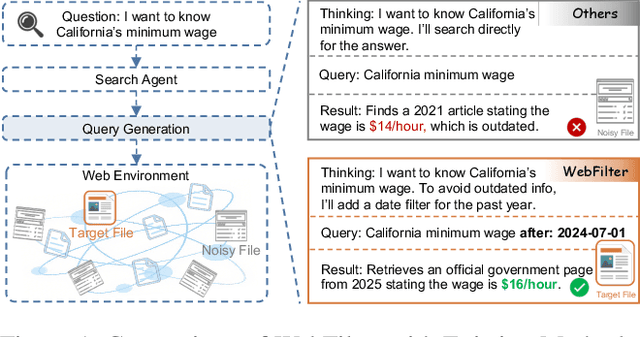

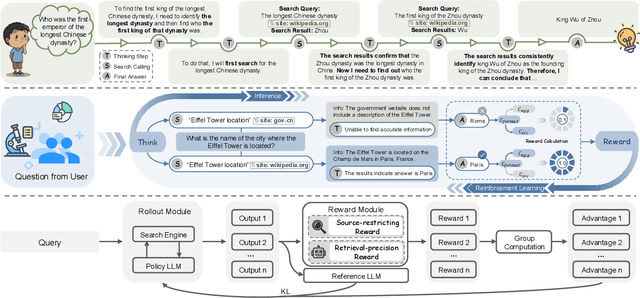
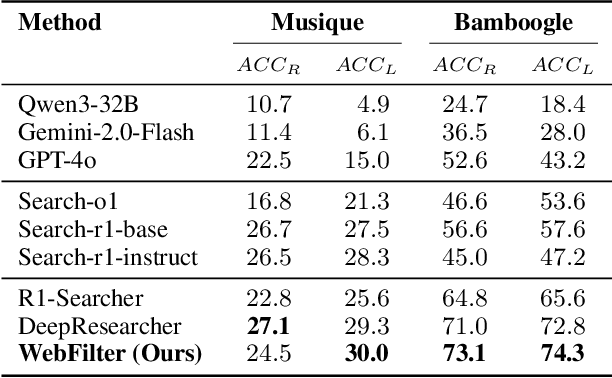
Abstract:Retrieval-Augmented Generation (RAG) enhances large language models (LLMs) by integrating up-to-date external knowledge, yet real-world web environments present unique challenges. These limitations manifest as two key challenges: pervasive misinformation in the web environment, which introduces unreliable or misleading content that can degrade retrieval accuracy, and the underutilization of web tools, which, if effectively employed, could enhance query precision and help mitigate this noise, ultimately improving the retrieval results in RAG systems. To address these issues, we propose WebFilter, a novel RAG framework that generates source-restricted queries and filters out unreliable content. This approach combines a retrieval filtering mechanism with a behavior- and outcome-driven reward strategy, optimizing both query formulation and retrieval outcomes. Extensive experiments demonstrate that WebFilter improves answer quality and retrieval precision, outperforming existing RAG methods on both in-domain and out-of-domain benchmarks.
RealFactBench: A Benchmark for Evaluating Large Language Models in Real-World Fact-Checking
Jun 14, 2025Abstract:Large Language Models (LLMs) hold significant potential for advancing fact-checking by leveraging their capabilities in reasoning, evidence retrieval, and explanation generation. However, existing benchmarks fail to comprehensively evaluate LLMs and Multimodal Large Language Models (MLLMs) in realistic misinformation scenarios. To bridge this gap, we introduce RealFactBench, a comprehensive benchmark designed to assess the fact-checking capabilities of LLMs and MLLMs across diverse real-world tasks, including Knowledge Validation, Rumor Detection, and Event Verification. RealFactBench consists of 6K high-quality claims drawn from authoritative sources, encompassing multimodal content and diverse domains. Our evaluation framework further introduces the Unknown Rate (UnR) metric, enabling a more nuanced assessment of models' ability to handle uncertainty and balance between over-conservatism and over-confidence. Extensive experiments on 7 representative LLMs and 4 MLLMs reveal their limitations in real-world fact-checking and offer valuable insights for further research. RealFactBench is publicly available at https://github.com/kalendsyang/RealFactBench.git.
Generalized Category Discovery in Event-Centric Contexts: Latent Pattern Mining with LLMs
May 29, 2025Abstract:Generalized Category Discovery (GCD) aims to classify both known and novel categories using partially labeled data that contains only known classes. Despite achieving strong performance on existing benchmarks, current textual GCD methods lack sufficient validation in realistic settings. We introduce Event-Centric GCD (EC-GCD), characterized by long, complex narratives and highly imbalanced class distributions, posing two main challenges: (1) divergent clustering versus classification groupings caused by subjective criteria, and (2) Unfair alignment for minority classes. To tackle these, we propose PaMA, a framework leveraging LLMs to extract and refine event patterns for improved cluster-class alignment. Additionally, a ranking-filtering-mining pipeline ensures balanced representation of prototypes across imbalanced categories. Evaluations on two EC-GCD benchmarks, including a newly constructed Scam Report dataset, demonstrate that PaMA outperforms prior methods with up to 12.58% H-score gains, while maintaining strong generalization on base GCD datasets.
Kimina-Prover Preview: Towards Large Formal Reasoning Models with Reinforcement Learning
Apr 15, 2025Abstract:We introduce Kimina-Prover Preview, a large language model that pioneers a novel reasoning-driven exploration paradigm for formal theorem proving, as showcased in this preview release. Trained with a large-scale reinforcement learning pipeline from Qwen2.5-72B, Kimina-Prover demonstrates strong performance in Lean 4 proof generation by employing a structured reasoning pattern we term \textit{formal reasoning pattern}. This approach allows the model to emulate human problem-solving strategies in Lean, iteratively generating and refining proof steps. Kimina-Prover sets a new state-of-the-art on the miniF2F benchmark, reaching 80.7% with pass@8192. Beyond improved benchmark performance, our work yields several key insights: (1) Kimina-Prover exhibits high sample efficiency, delivering strong results even with minimal sampling (pass@1) and scaling effectively with computational budget, stemming from its unique reasoning pattern and RL training; (2) we demonstrate clear performance scaling with model size, a trend previously unobserved for neural theorem provers in formal mathematics; (3) the learned reasoning style, distinct from traditional search algorithms, shows potential to bridge the gap between formal verification and informal mathematical intuition. We open source distilled versions with 1.5B and 7B parameters of Kimina-Prover
PC$^2$: Pseudo-Classification Based Pseudo-Captioning for Noisy Correspondence Learning in Cross-Modal Retrieval
Aug 02, 2024



Abstract:In the realm of cross-modal retrieval, seamlessly integrating diverse modalities within multimedia remains a formidable challenge, especially given the complexities introduced by noisy correspondence learning (NCL). Such noise often stems from mismatched data pairs, which is a significant obstacle distinct from traditional noisy labels. This paper introduces Pseudo-Classification based Pseudo-Captioning (PC$^2$) framework to address this challenge. PC$^2$ offers a threefold strategy: firstly, it establishes an auxiliary "pseudo-classification" task that interprets captions as categorical labels, steering the model to learn image-text semantic similarity through a non-contrastive mechanism. Secondly, unlike prevailing margin-based techniques, capitalizing on PC$^2$'s pseudo-classification capability, we generate pseudo-captions to provide more informative and tangible supervision for each mismatched pair. Thirdly, the oscillation of pseudo-classification is borrowed to assistant the correction of correspondence. In addition to technical contributions, we develop a realistic NCL dataset called Noise of Web (NoW), which could be a new powerful NCL benchmark where noise exists naturally. Empirical evaluations of PC$^2$ showcase marked improvements over existing state-of-the-art robust cross-modal retrieval techniques on both simulated and realistic datasets with various NCL settings. The contributed dataset and source code are released at https://github.com/alipay/PC2-NoiseofWeb.
A2: Efficient Automated Attacker for Boosting Adversarial Training
Oct 07, 2022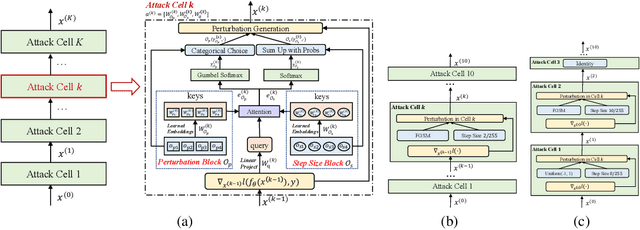

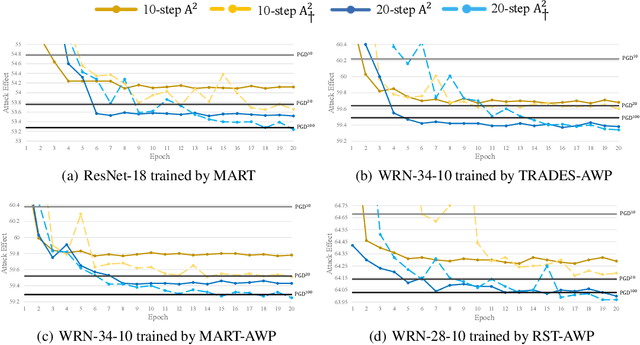
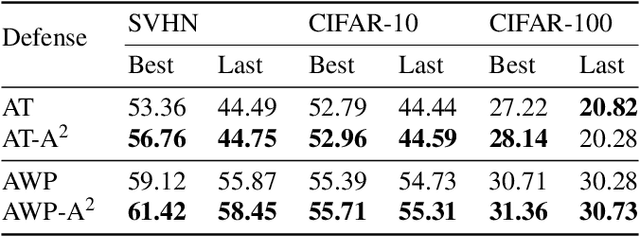
Abstract:Based on the significant improvement of model robustness by AT (Adversarial Training), various variants have been proposed to further boost the performance. Well-recognized methods have focused on different components of AT (e.g., designing loss functions and leveraging additional unlabeled data). It is generally accepted that stronger perturbations yield more robust models. However, how to generate stronger perturbations efficiently is still missed. In this paper, we propose an efficient automated attacker called A2 to boost AT by generating the optimal perturbations on-the-fly during training. A2 is a parameterized automated attacker to search in the attacker space for the best attacker against the defense model and examples. Extensive experiments across different datasets demonstrate that A2 generates stronger perturbations with low extra cost and reliably improves the robustness of various AT methods against different attacks.
 Add to Chrome
Add to Chrome Add to Firefox
Add to Firefox Add to Edge
Add to Edge